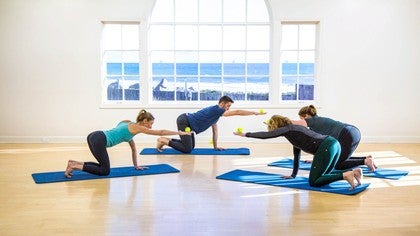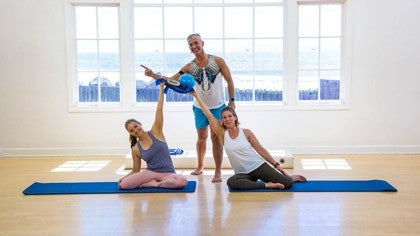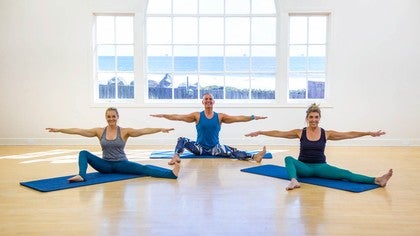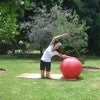Description
About This Video
Transcript
Read Full Transcript
Hello there. My name is Juanita. I'm a physical therapist, movement practitioner from Spain. Uh, let's uh, do a class. Um, we're going to be focusing in two main aspects. First is out of alignment. So everything we are going to do is going to be out of alignment. So no front to play, no sagittal play, no perfect access. So that's one of the rules that we are going to do. Um, and on the second part we're gonna be adding a little, uh, elements that is going to create two are going to create two, uh, uh, problems perturbations into the way we move and destruction into our attention and let it out. We ex, I will explain why we doing that, but first we're going to move out of alignment. So the first exercise is a heel raise. Okay? So let's do a heel raise.
And every time you do a heel raise, it has to be
Sometimes is quite rigid and that's a little vague. But here you realize that there are many, many ways of creating this. Okay. So the second exercise is we're going to be doing a little jump on one foot. Okay. So we want to land on the ball of the food was, we are going to be doing a lot of stuff standing and we're going to be using the ball of their food a lot. So I want to have like a very clear version vision of it in, into our brain so we jump and stuff.
Um, okay. So we're gonna do five with one leg, with one leg jump stop, balance and back. And you make it as difficult as you as you like. Okay, sure. Jump.
This is like the dumbest food ever.
External. We can turn to one side to the other. We go half one more aligned. The other one is out.
All the joints, all the muscles.
So we are going to do is get into disc brushes. Okay. So one for this, ah, on, on front. And the other leg is grossing behind the heel. Okay. So we can, we're going to use our hands to support. Okay. So now we are going to change
So we shift like this, uh, shift like this
One knee is pointing in this direction, the other knee is pointing in that direction. Yes. So now we support easily with our hand. Tap your toes. Untuck the toes change. We can use our hands, no problem at all. And then you go check your toes and then you see it. Fantastic.
So
Oh, okay. So you think you've got this. So now we're gonna create a change, but we're gonna add more movement, more muscles. So from this position, from the low a fishermen squat, we are rolling to one side. Very silly. As soon as we take our back into the floor, we change legs. Okay? So we changed the position and then we roll over and with very little support that the hand, but with some we'll come back to this position and then we roll. We roll down on the spot like this, change
Try to feel less. Need of using your hands, using your legs. And you can start like throwing the movement forward. Yeah, imagine that you have a ball here that you want to throw. Yes. So here you throw it. So now this circle is not as big. It's more, yes. So you open and then you close.
So then you open, then you close. That's it. One more time open and then you close. Okay, cool. For the next exercise, we're going to take the mat. We're going to bring in here. So let's go. We're going to do bridges. But again, because the topic of the first part of the class is out of alignment, we're going to create a little, a little change. Um, what is important is that more than a bridge is a rich.
So we want to reach and the hand actually is what is going to lead. This is going to create the movement. Okay? So let me show you a couple of times. So if I'm taking my right hand, I'm going to take the right hand over the head to the left side. Like if I wanted to haul your foot. Okay, so I'm going to do this.
So the movement here and the intention to move is what is going to create the lift into the bogus. Okay. And then I'm going to do the other side. Okay? Again, we are not looking in a very perfect articulated Brits. This is not the purpose. Now it's okay if the pelvis goes ah high. It's okay if it's more like a shoulder bridge that we take the, the higher deters. No, any contraindication.
Focus on that task on the movement on the rich. Okay, so we're going to do five from five on a particular rhythm. So we start with right hand and reach one back and one to the other side. Back and chew and look. Use Your eyes to into the hand. Three Elvis up three and roll on your shoulder for Raul on the shoulder for really rich. Connect with your feet. Five, five, another one,
Okay, cool. So
That one, yes. And to the other side.
Okay. I think that's enough.
I don't want the tennis ball to fall. Okay, this is what I don't want you to do. A W you can also come play with different elements. That is gonna take you out of alignment. And again, life is out of alignment. Alignment is overrated. Symmetry is completely overrating because life is a symmetric.
Everything we do is as a metric and everything we do is out of alignment. Even when we believe we are not, even when we walk on where we run, it looks like there's a sagittal pay movement. But in generally there's a lot of movement getting in and out of that alignment. So, so the best idea after we learn what is a proper alignment or we have a, an idea and understanding of what is alignment is to move on the boundaries of that alignment to expand our capacity on a, onto protect our tissues. Because that is going to happen in our life, especially when we are child and when we're stress, et Cetera, et cetera. Okay?
So we're going to take a first, some tennis balls we can adjust. Just make sense with them. Okay. So next part of the class we're going to be using in tennis balls a, they're going to create very interesting challenges for us. Again, um, just having a little, uh, object like this that is, uh, falling all the time is gonna prevent us to fall into repetition mode. Like repeat and repeat and repeat the same thing. It's impossible to repeat whether it's something that is, uh, having its own rules and it's on behavior. So, so one of the things that is interesting to understand is that the only thing that doesn't create any neuroplasticity is repetition. When you, we are doing repetition, the body, the brain is into prediction mode is just filling the gaps so it already knows what is going to happen next. So I didn't, these little things keep us into the learning mode and again, it drives our attention from the exercise into a task. So, so that's completely different. Now. It's not an exercise, it's more like a game. It's like something we need to, to figure it out. Okay.
I know there are element that creates, is makes us a little bit more uncomfortable. So it makes us uncomfortable. This creates a tension that we need to figure it out because we don't want to be uncomfortable. So our buddies fighting all the time in order to create that sense of control. Okay. So we're going to use the ball in the, in the back of the hand like this. So there's many ways of uh, taking it that that's, that could be one.
So first thing we're going to do is just do our little hard squat. Okay? Yeah. That's the stressor. Okay. So half squat vertical.
Got It. Okay.
If you want to play, you can take when you feel you ready, one ball out of your peripheral vision and without you noticing is going to create this Kartik alignment is gonna change the way to truck your legs, which is a very interesting thing.
You know what happened there. You can focus on the button and this is normal. This is probably the first thing. You do this and and you need to figure it out. You need to figure it out. What is not as good as as you want or as you thought it is going to happen.
Okay. So we add some rotation there.
That is something that you can see your ability to do a lot. So we're going to cross one leg and then we're going to try it. Sit as low as you can or as you want and then you come back up and then make it wider because it's going to be helpful for you. And then you go, yeah, like that. Okay. We're going to do a couple more times.
Make sure you just spread your toes manly. So really, really art's Yes and do it very, very slowly so you can understand that we do in like Canada, kind of a, an accelerating approach into this. So we usually can start with a half squat for a couple days. Then we'd go into their full squad. So this is just to show all the different possibilities that we can get. We're going to make another one that is, that is difficult.
So we are going gonna uh, go down into the curses squat like this and then try to turn Yup. And then she can stand. Same or you can roll do this. Say this. Say where did you go? But I want to add some rotation. Let's see. That's better. So we're gonna open it. If you want to rotate and make a y there, curtsy squat roll on the ball of the foot and just spin and change, then you can go up and then we can switch to the other.
So I'll take them months.
And then roll, um, make sure that you are focusing in transporting the balls forward. Yeah. Good job. I know it fits too much. You can take only one hand. That's, that's okay. So you can only take one hand. So now we're gonna roll. Make sure you open the hip, make sure you use the weight of your feet, but eventually you want to focus on the ball. Okay. And again, move the ball forward in order to lift.
So the arms are going to create this motion. Yes. It's interesting right there. The way we do it. We don't, oops, we don't focus so much in the movement, but the movement keeps or even improves its quality. Yeah. So let's do it again.
And now only one leg is going to be straight. And then we're going to roll back. And this is again taking a house, taking us out of alignment. I'm going to come back down and then we move in. A little slight diagonal. Yes. So now everybody needs to understand how we do this. Okay, so now chains to the other set position. The other mermaid position. Make sure you don't fall.
No check. Whoops. One leg out and then roll down. Oh no ones. So this time we're going to straight our legs. You're gonna Roll
Yes. Good job. And again, then one roll, then extend the other. Finish your role. We were all up in the side of the plane and then we figured out the way of moving hips as synchronized as weekend. Okay. And then we extent slowly keeping that control and then we roll back, extend the other leg,
Yes. And let's see if we can stand up from here. So we want to go into a tall kneeling position. We're gonna shift legs. You're gonna sit into a mermaid position again. Good job. Wow. Well done. Okay. Focus on your shoulders and everything that there is not an excessive tension.
You're going to do it again. Pelvis forward, then you change, then you sit up one more time. Pelvis forward change. It's interesting to see how just shifting the focus make us move sometimes much better. Like with less attention to detail that maybe doesn't matter too much. Okay, so now from here we're gonna extend the back leg. We're going to extend the other one.
We're gonna close the first. We're going to take a sec. Okay. So now we're doing on the floor. So extend, extend, flex and flex like that. Okay. One more time. Extend. Extend. And now in the kind of a long, simple, long seat position or sole position, we're going to stay. And because we've been with the balls for a long time, we are going to rest a little, okay.
Make some circles with the shoulder blades. If you need, move the neck position that you feel like. Okay. So now we're gonna focus in a, in another task. Let's try to sit on the seat bones and we're gonna bounce the ball
So why did you do in days you can play with two balls. Synchronize and synchronize. You can do many [inaudible] you want to play. You can do many, many things. A, you can also play with different elements that you can, you can add. But the idea of getting your attention into a, an element and trying to figure it out is it's like a meditation is really, really, uh, ve embracing and really interesting to do from, from 10 to 10 specifically with all the populations that they need to create that some sort of uh, attention. Okay. That's for you. Yeah. Okay. So now the next one, take the balls into the position again.
Um, we're going to do a long spine straight and then we take the shoulder blades back into retraction, into the lung seat position. Shoulders down, retraction. Go into the seat bows and then lengthen forward. Great job. Yeah, it is. I know. So the shoulder blade has to be in a nice organization to know that you did this without, uh, falling the boats. So one more time and then start the movement from there. Retraction. So think and taking the, show the blades back and you're going to experience that.
That chest wants to go up and forward. Okay. So can we do a song with this for sure. So let's rotate slowly. Just rich up to the position that you really control. Don't lose your attention into the back, uh, tennis ball. And then you can, oops, you can come back again into the center and let's go to the other side. Nice. Nice.
We're rotate slowly. Yeah, there's a lot of elements that we need to focus in. This part controls your rotation. We're going to do a couple of each side.
So first I want you to get a comfortable position. The city has to be here. If you are comfortable here, can be here, but I want you to focus on
Oops,
I usually like to have a little bit more than 90 degrees of flexion in the hip. So I use that reference that the knees are under the belly button. Uh, make sure that you get sort of Lumbar Lordosis, not eh, not extension but just it's neutral curve because sometimes we tend to stay in too much, run their position. So again, take one ball into one hand, balance your weight between the four points, the six points as you have, and then try to go into shoulder flection. You can look at the ball if you like and then you come back. If you want to do it into a diagonal, that is fine. If you want you to do it to the PSI, that is interesting too.
So slow it down when it's necessary. If you want to cross. So if for whatever reason you want your students to be into quite a bit position for a long time and do the one then to be bored. So this is a very nice alternative. So if you wanted to make it more interesting, we can go into shoulder flection and contralateral hip extension and balance. That way we can rock forward and back focusing on that control of the ball.
So eventually you get more control. You can combine, uh, shoulder flection with contralateral hip extension on the other side. And you can rook forward and backwards if you like. And again, now that you have the idea, you will discover a lot of applications of this. Okay, cool. Fantastic. So last thing we are going to do, we're going to work in a in a button that I, that is really interesting. It is called the Turkish get up is not up. You like this exercise a but is a, I think it has a lot of value because there's many, many elements that we need to, to cover and we're gonna add a, an element of a disruption of perturbation. In this case we're gonna, we're gonna use the herb Yoga blog, uh, one of cork that is quite heavy because we need, we need that feedback.
So I'm going to bring them and I'm going to explain to you the, the button. So
So we're going to start all together. I think we can, we can do it all together. Okay. So if you extend the legs and you open their contralateral knee to the side, yeah, that's, that's gonna be a, a nice position and then you're going to extend it. Okay. So this is how we are going to start to extend the knee. The other hand, you touch your hip with the elbow on the floor and then again you extend the, uh, so this is the position that you are going to get into the, into the arm. So the first movement is ah, protraction. Okay, we're going to practice this a couple times.
So we do our protraction over the yoga block. Make sure that you're not holding it. You can, but the idea is, uh, that is a bit free to fall. Eventually. Uh, it could fall back. It's strange. It's rare. It doesn't happen too much. Once you have done, uh, protraction, you're going to go into
So from here you're going to extend the elbow and you keep looking at the break. Okay? So the break has to be on top of you. Now they're ipsilateral foot. So the same for the has their cork and the other hand are gonna make a Brit. So you're gonna lift your body and take the leg behind the bridge, that free leg behind the bridge.
So you are going to sit a little bit in the hill, okay? And then you're going to go into these lines. Position. Do you align yourself? Okay? So now you are in alignment.
And then in the same line of the thigh and the knee support on the floor. Okay, so this is the same line like this. You keep
Then you extend the elbow protraction, flection and rotation.
Same Line into the right
Okay, so
Keep looking back. Now we sit in order to center and then you can churn or you can turn, you can, you can decide what is easier for you. Now is stop looking at the yoga block. Take the Belvitas up and forward and again, contralateral Lech back. You turn the leg, look, follow the knee support in the same line, pass the weight into the hand, extend the leg, elbow, shoulder and come back. And one more time.
Protraction, keep pushing. Go into the elbow, open the chest, look at it, slide the hand, align your lunge position. And back, back lunch with the contralateral leg turn, look for the na their knee, get us support fast in the leg and from here elbow, shoulder and then you come back. Okay, cool. Oh was it? It's interesting. Okay. So uh, this is an exercise that usually is made with weight, but I think it's more interesting to do it without any way than with a controlled situation. And then to load it because loading it sometimes too early. Uh, it, it is hiving some of their movements that we have not so clear. Okay.
And we're going to end with a, uh, the last exercise. This is going to be a little bit challenging and we're going to go as far as we as weekend. So the idea of of the exercise is to support log into the food. Okay. Just like this. I like this. Okay. And then you are trying to roll.
You can do it completely, but it's not necessarily okay into prone. Okay. So this is a real hip opener. You go until you feel it's too much and you can try again. Okay. Again, it's not a lot of rules here. The only rule is trying to keep the yo I block in place.
It's like a rocky boat.
The good thing about this is even though it's challenging, it is, it is an interesting one. So people get hooked into it.
Anything Goes - Playlist 6: Playing with Pilates
Comments
You need to be a subscriber to post a comment.
Please Log In or Create an Account to start your free trial.





















